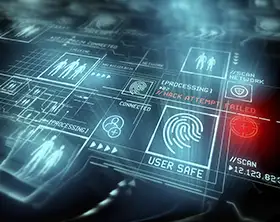Best Practices for Ensuring Strong Business Continuity
In the post-COVID times, military conflicts, political disturbances, and economic challenges, most organizations have finally acknowledged that in the fast-paced world, their earlier policies are no longer sufficient to deal with the newly emerged risks. To future-proof business, defy challenges, and seize unparalleled opportunities, they understand the need to prepare accordingly.
In fact, the number of crises the world faces today and how they impact each other made the World’s Economic Forum use the word “polycrisis” in the Global Risks Report 2023 to describe the current and future state of affairs. The report also represents the results of the latest Global Risks Perception Survey (GRPS):
Allianz Global Corporate & Specialty has analyzed the responses of more than 2700 people from 94 countries and across 23 industry sectors with the view to highlighting the most important global business risks for 2023. As a result, cyber incidents and business interruption are leading in the survey.
To protect their business from future crises, organizations must reassess their business continuity plans.
What Is a Business Continuity Plan?
A business continuity plan (BCP) is an operational document, outlining how an enterprise will operate in the event of a disaster and continue to provide services. A business continuity strategy specifies disaster recovery approaches for restoring IT infrastructure, servers, applications, network connections, and any other resources required to run business operations. In addition, it provides a larger set of instructions for all teams on their responsibilities and actions toward regaining normal operations.
The purpose of a business continuity plan is to ensure the rapid recovery of your operations, as well as minimization of operational downtime and data losses. Having a systemized approach to business continuity management also helps to ensure the immediate resumption of services after an unplanned event.
Given the current uncertain business climate, implementing a business continuity plan is crucial for ensuring greater operational resilience and protecting your company against internal and external volatility.
Why Is Business Continuity Planning Important?
During the significant events that have happened in the last couple of years, such as the global pandemic, the Russian invasion of Ukraine, and natural disasters, many businesses recognized the importance of business continuity planning. They were unexpectedly forced to make prompt decisions and enable remote access to a large number of business applications, services, and data centers.
The pandemic was the first massive incentive that propelled companies to bring about digital transformation. This crisis made many companies shift to remote work but also presented a new opportunity to speed up the implementation of advanced cloud technologies and adopt new digital products. Almost 92 percent of digital leaders globally have implemented cloud technology on a small or large scale as of 2023.
Now, however, a new challenge arises – with greater reliance on digital products, data storage, and supporting IT infrastructure, business leaders now need to ensure business continuity across a wider range of assets.
Given that cyber incidents, including cybercrime, system downtime caused by malware and ransomware, data breaches, fines, and penalties, are the most considerable business threats, further digitalization without proper continuity planning can accelerate, not mitigate, the operational risks.Besides, the scope of business continuity plans also pertains to data backups and protection – another crucial aspect for ensuring business-as-usual operations, as well as avoiding regulatory penalties.
As many operations have been restarted cross-industry, taking proactive business continuity planning steps is essential for ensuring that the new hybrid IT environments are as secure, strong, and resilient as possible.
Business Continuity Planning Steps
Digitally transformed companies now operate hybrid IT environments, which are a mix of private and public cloud as well as on-premises data centers. While such operational setups diversify the risks, they also require more diligence regarding infrastructure monitoring, and performance optimization. The reason for that is that a single-element failure can cast a ripple effect over your entire business infrastructure. The reason for that is that a single-element failure can cast a ripple effect over your entire business infrastructure.
A comprehensive business continuity planning creates a clear recovery pathway for your systems and an operational blueprint for your personnel.
At Infopulse, we recommend our clients implement a business continuity system based on the following business continuity best practices.
0. Determine Threat Scenarios and Critical Activities
Before creating a business continuity plan, one must identify a range of potential threat scenarios, internal and external risks. Certain types of threats may be more prevalent in certain locations than others. For example, a company can be located in an area with a higher threat of earthquakes. Power outages are more likely to occur in areas with less robust electricity supplies. Some cases, like the company’s security weakness, should be identified regardless of location.
It is also crucial to identify core activities and services in the organization that must be continued during and after a significant disruption that must be aligned with stakeholders and clients. By identifying the most important, it becomes simpler to prioritize the activities for continuous delivery, estimate the recovery time, and consider issues.
1. Develop a Detailed Business Continuity Plan
A business continuity plan (BCP) is a master checklist, outlining the following:
- Complete hardware and software inventory
- Required data backups and backup site locations
- Main disaster recovery solutions and sites
- A designated alternative site for operations
- Contact information of emergency respondents
- Notification matrix, suggesting who should be informed
- Communication plan for employees, clients, and other affected stakeholders
- Blueprint for the recovery plans
The goal of a BCP is to provide exhaustive information regarding the backup sites and disaster recovery services, specify who is responsible for business continuity planning and recovery efforts, and how different teams should respond. Plans should also include step-by-step operational strategies for ensuring operations during short-term and long-term disruptions.
Below is an example of a business continuity plan, used by IBM Global Technology Services:
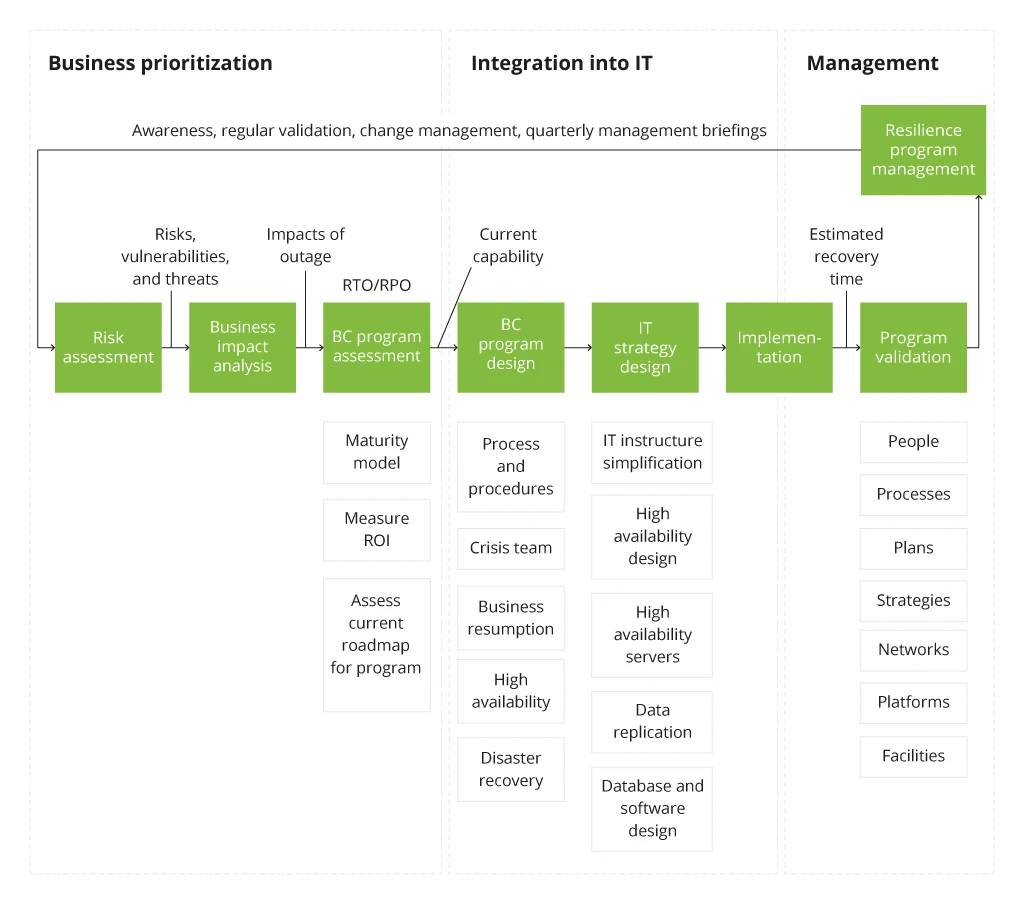
2. Implement 24/7 Infrastructure Monitoring and Support
Infrastructure monitoring tools help assess and diagnose the performance of all your technical assets – on-premises and cloud systems, networks and servers, virtualized environments, and any other portfolio items. By knowing how your systems operate, you can catch the early signs of potential disruptions due to network saturation, malware, unplanned downtime, or external intrusion.
Considering that most enterprises have significant technical portfolios, with infrastructure residing in on-premises data centers, IaaS, and PaaS cloud platforms, along with edge devices, infrastructure monitoring software can also ensure complete visibility into all assets and subsequently enable faster discovery of incidents.
The best infrastructure monitoring tools provide real-time insights regarding performance degradation and can be configured to:
- Run 24/7 automated monitoring of networks, servers, applications, and databases, regardless of their location.
- Perform proactive performance measurement and provide recommendations for improvements.
- Provide a detailed classification of incidents and steps for resolution.
With well-configured IT infrastructure monitoring, you can achieve nearly 100% service availability of business-critical operations 24/7 as one of our clients did. In addition, you can reduce the operational costs of monitoring by selecting an automated monitoring solution and having an eternal L2/L3 support team on the frontline. That’s exactly what another Infopulse client did to improve their customer service levels – learn more about this project in our case study.
Improving collaboration between all levels of support and its quality for the end-users.
3. Create a Disaster Recovery Strategy
A disaster recovery plan is the cornerstone of BCPs. However, the two terms often get confused. Thus, to clarify: what is disaster recovery?
Disaster recovery (DR) is an annexed plan, specifying the main strategies, policies, and procedures for managing IT disruptions and returning to full operations after unplanned interruption.
In this sense, when comparing disaster recovery vs business continuity, you should note that:
- Business continuity planning spans multiple operational processes and departments. It’s a master plan for mitigating the disruptions and regaining control.
- Disaster recovery is a key part of BCP. However, the operational focus here stays on IT systems, as well as data recovery.
A standalone DR plan includes the following documented elements:
- A complete list of hardware and software assets, ranked by criticality;
- Baseline recovery point objectives (RPO) and recovery time objectives (RTO) for each set of applications;
- Key personnel responsible for executing the disaster recovery plan;
- A list of disaster recovery sites and disaster recovery software;
- Extra instructions for customers and employees.
Your DR strategy should be designed around your recovery goals, based on the RTO and RPO values for different types of assets.
For example, critical customer-facing solutions will require a hot disaster recovery site – one offering that can accommodate a full copy of your production site, including instant data backups. In such cases, businesses opt for cloud-based disaster recovery as a service (DRaaS) solutions that provide RTO in minutes and RPO in seconds.
Less critical systems (i.e., those that can tolerate longer recovery) can be placed in warm sites. These act as remote backups of your production site; however, they require extra time and effort to establish hardware and network connections.
Lastly, your DR plan should also specify cold sites – remote, yet more affordable locations that require extra configurations to become fully operational. Cold DR sites are the optimal choice for backing up non-critical data (e.g., information that you store due to compliance requirements).
Apart from ranking applications (and data) by recovery priority, your DR strategy should further specify the end-to-end recovery process that includes data backups, archiving, restore procedures, and cleanup.
In addition, ask your internal DR team or external consultants to:
- Select, configure, and implement a continuous deployment (CD) toolkit to achieve a smooth recovery.
- Verify that DR sites have the same security and compliance configurations as production sites.
- Check the overall security of your DR process, along with access management policies.
4. Raise Employee Security Awareness
Even the best-in-class business continuity solutions will fall short if business users fail to follow the basic IT security best practices.
Cybercrime incidents, such as IT outages, data breaches, and ransomware attacks, cost the global economy well over $1 trillion annually — around 1% of global GDP, according to Allianz Global Corporate & Specialty.
Disaster recovery and business continuity plans can help deal with the aftermath of an attack or data breach. However, they’ll eventually have no impact if your teams do not understand:
- How their daily actions contribute to operational disruptions.
- How to report suspicious activities and escalate an issue.
- What their roles and responsibilities are in the BCP process.
Make basic cybersecurity and business training mandatory for all personnel to help them develop adequate cybersecurity habits.
5. Conduct Disaster Simulation Tests
Having a BCP and a DR plan is just one part of the equation. To effectively act upon them, you need to know how to test a business continuity plan. If you have recently implemented a new plan or adopted new business continuity software, organize a stress test for it.
In order to do that, create an environment that simulates an actual disaster (e.g., data center power outage). Assess how all involved infrastructure and personnel will respond. If you wonder how often an organization should test its business continuity plan, a recommended practice is once per year at least.
To monitor the effectiveness of your plan, set forth several business continuity metrics:
- Target RPO (recovery point objectives)/RTO (recovery time objectives)
- Target SLA (service level agreement) levels
- Mean time to recover a business process
- Difference between target and actual recovery time
Observe your team responses and document where they struggle. Finally, analyze the findings to determine knowledge and processual gaps in your plans.
How to Ensure Business Continuity
To ensure business continuity, you need to make sure your BCP is feasible, practical, and up to date. In addition, a business continuity plan must be supported by the top management and then by all the company’s employees, who should be highly aware of the plan, its steps, and the role they play. It is the responsibility of senior management to create and update the plan; workers cannot be tasked with such responsibility. It is also likely that the plan will remain feasible and up to date if management devotes enough time to its testing.
Conclusion
So, why is business continuity planning so important? The latest events, such as pandemics, the Russian invasion of Ukraine, natural disasters, and political turmoil, have shown that companies are operating in a climate of increased instability. An effective BCP includes detailed information about disaster recovery efforts, specifies who is responsible for continuity planning, and outlines how different teams should react.
While a BC/DR strategy cannot fully protect you against all unprecedented events, it can drastically reduce the recovery time, help mitigate rising cybersecurity risks, increase overall technical resilience, and keep the company up and running while recovering from a disaster.
Frequently Asked Questions
1. How often should an organization test its business continuity plan?
As a recommended practice, your business continuity plan should be reviewed at least once per year at a scheduled time to ensure its effectiveness and relevance in mitigating potential risks and disruptions.
2. What is the relationship between business continuity and risk management?
Historically, business continuity management (BCM) and enterprise risk management (ERM) have often been viewed as separate entities. BCM is a process that helps to identify and effectively respond to interruptions that can jeopardize the organization’s continuity of its operations and services. In response to unexpected and anticipated business interruptions, BCM aims to enhance enterprise resiliency.
Risk management involves identifying potential events that could negatively affect a company, as well as dealing with risks. Simply put, the main task of risk management is to identify, evaluate, monitor, and report significant threats that could negatively affect the achievement of an organization’s strategic goals and operational objectives. Simply put, ERM enhances an organization’s ability to make risk-informed decisions.
The objectives of both business continuity and risk management are to identify, assess, and mitigate interruption risks that could prevent the company’s goals from being achieved.
3. When should you activate a business continuity plan (BCP)?
Whenever an unexpected event threatens to disrupt business operations significantly, a business continuity plan should be activated.
4. What is the main purpose of the business continuity policy?
The primary purpose of any business continuity policy is to help speed up an organization's recovery from a threat or disaster.
5. How to test a business continuity plan?
Business continuity plans benefit from stress tests. The best way to do this is to simulate a disaster (for example, a power outage in a data center). Evaluate how all infrastructure and personnel will respond to the simulated disaster.
6. How to create a business continuity plan step by step?
Before creating any business continuity plan, you need to identify a range of threat scenarios, external and internal risks and define the organization's main activities and services. After that, you can develop a detailed business continuity plan, outlining the following:
- A thorough inventory of hardware and software
- Identification of necessary data backups and their storage locations
- Establishment of primary disaster recovery solutions and backup sites
- Allocation of a designated alternative operational site
- Compilation of emergency response contact information
- Development of a notification matrix to streamline communication
- Formulation of communication strategies tailored for employees, clients, and other stakeholders
- Creation of a detailed blueprint outlining the steps for recovery
7. Why is business continuity planning so important?
When an organization experiences an unexpected disruption, such as a natural disaster, pandemic, cyberattack, or political shift, a business continuity plan ensures the organization remains resilient and continues to provide services. By doing so, essential functions are maintained, and downtime is minimized.
8. How to measure business continuity maturity?
To measure business continuity maturity, you can use business continuity maturity models. These are special tools used to improve disaster recovery processes and determine an organization's level of preparedness for business continuity. A maturity model examines an organization's current state from a specific viewpoint and helps the organization advance to its ideal state.
9. Who is responsible for business continuity planning?
In most organizations, the chief executives like CEO, CFO, COO, and other executives are responsible for establishing and maintaining a business continuity plan.

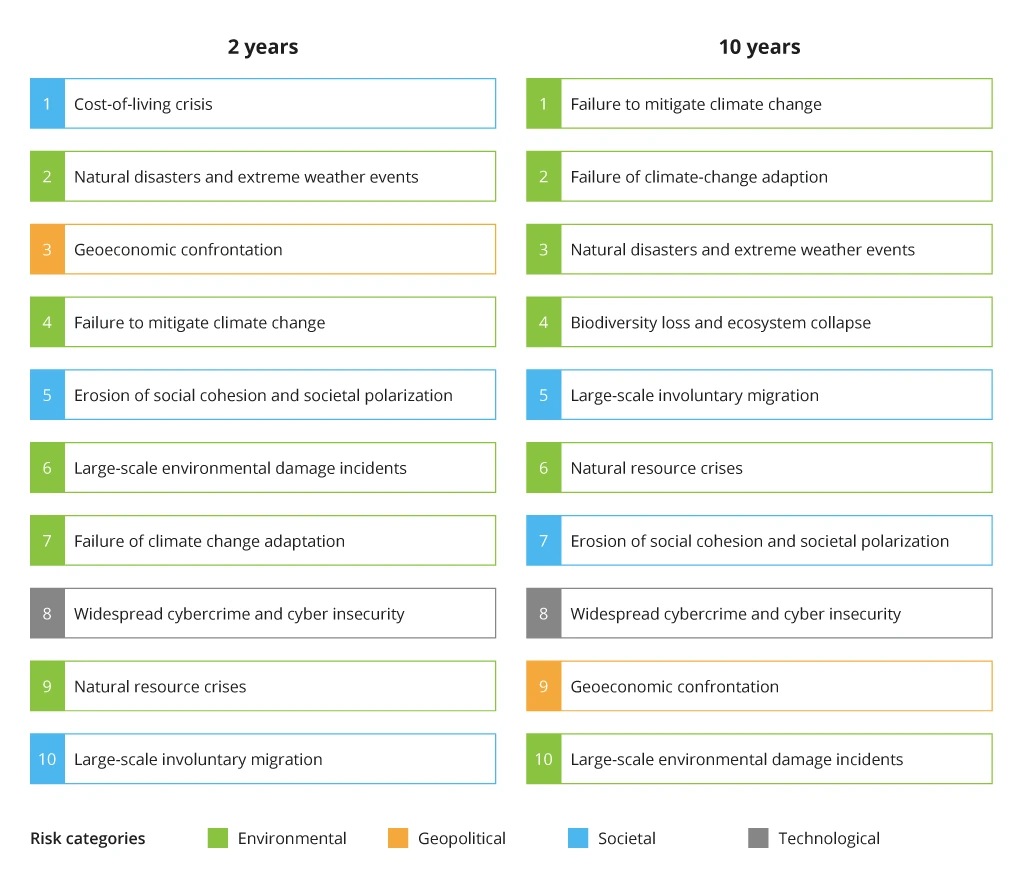
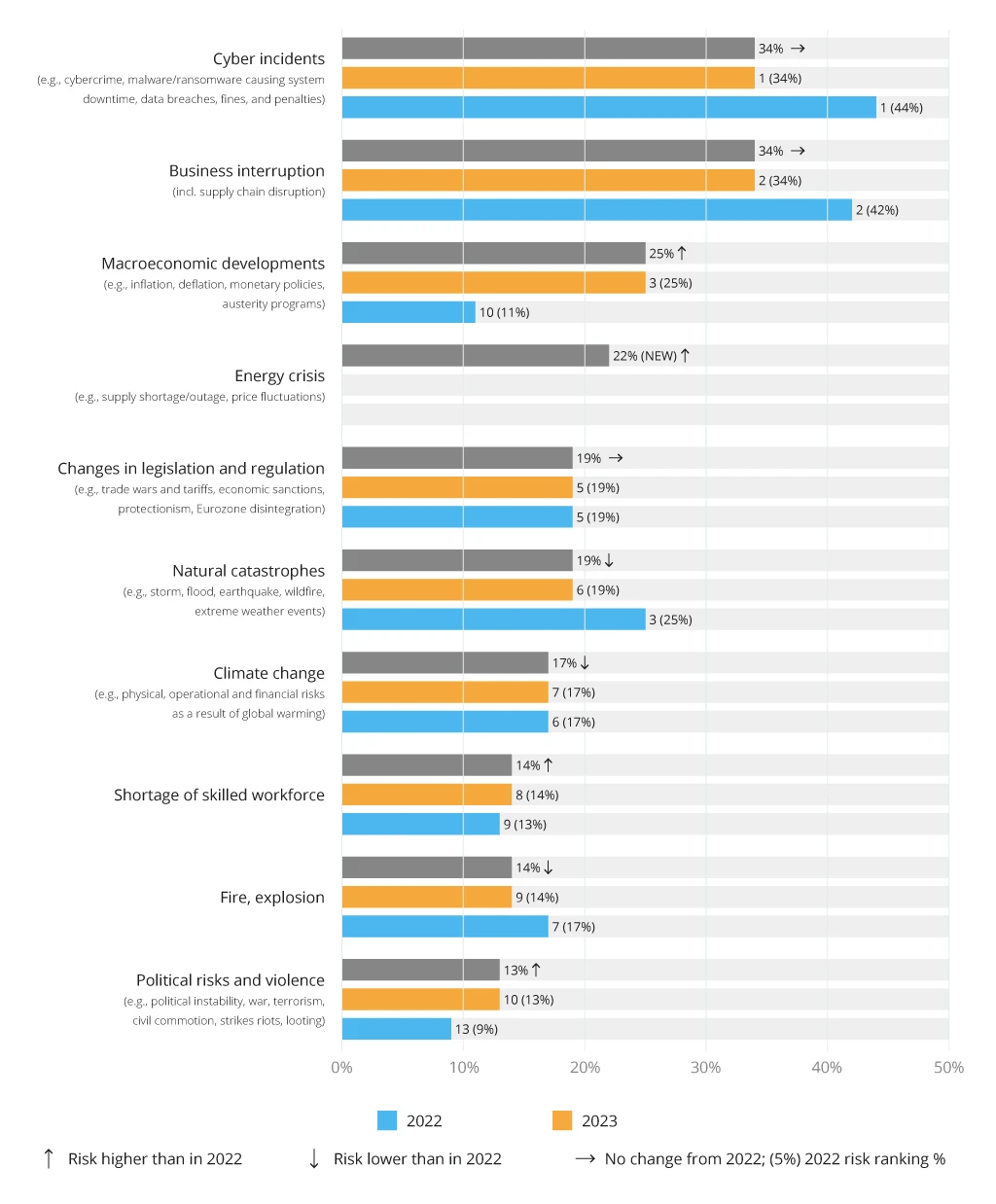
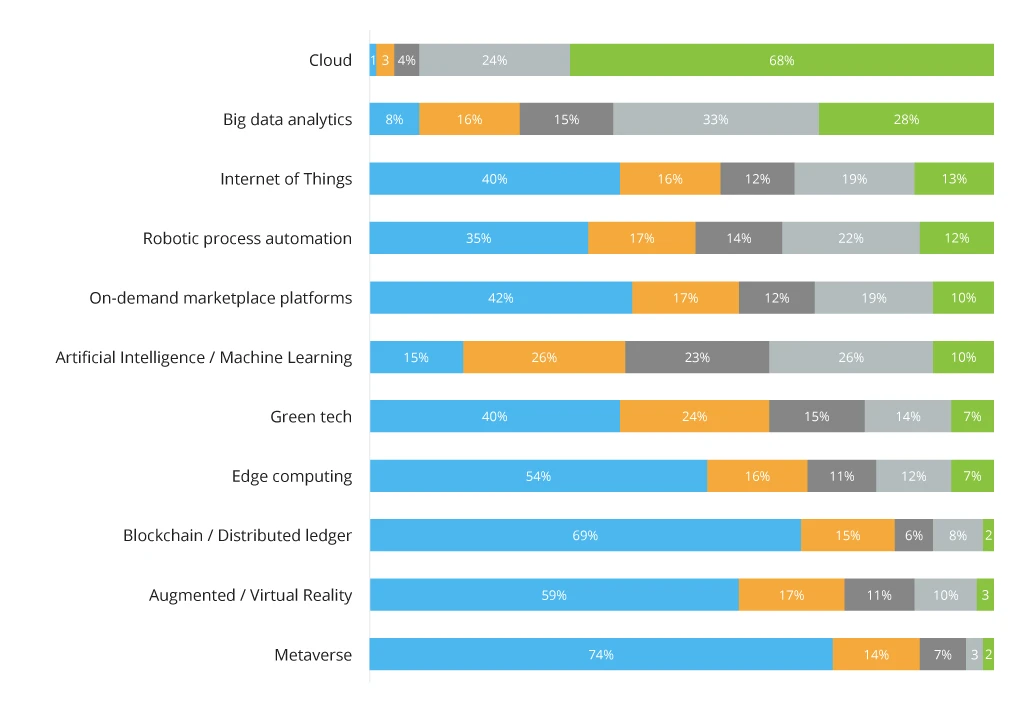

![BCDR for smbs [thumbnail wide]](/uploads/media/thumbnail wide-454x222-business-continuity-and-disaster-recovery-planning-for-smbs-and-enterprises.webp)
![How to Centralize Enterprise Security System [thumbnail]](/uploads/media/thumbnail-280x222-how-to-centralize-enterprise-security-system.webp)
![Infopulse BCP im Detail [thumbnail]](/uploads/media/article-infopulse-bcp-implementation-280x222.webp)


